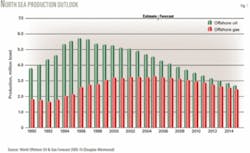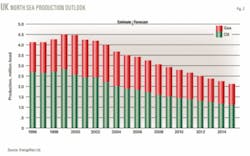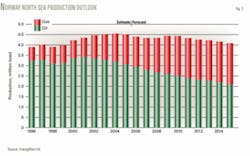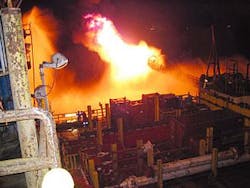The past 2 years have seen major changes in the fortunes of the industry in the North Sea as oil prices have doubled, money has flooded into oil stocks (some of which have more than doubled), and drilling rig rates have rocketed.
The oil and gas sector has always been highly cyclical. As a company, Douglas-Westwood has long forecast the potential for a major increase in oil prices, but the speed of development over the past 2 years has taken even us by surprise.
The situation the world faces now is virtually unprecedented-previous oil price shocks have been caused by politically induced supply restrictions such as experienced in the Middle East wars of 1973 and 1979. This time it is very different, with high oil prices driven by a remarkable growth in demand from China (and to a lesser extent the other developing economies).
The situation is also echoed across all other energy sectors with China’s total energy demand increasing by 81% in the last 3 years.
Oil supplies have been unable to meet growth in demand, and oil prices have surged. Compounding the situation has been a decline in oil production from mature areas such as the North Sea (Figs. 1-3). Although there is some potential for oil price declines in the short term (as more projects come on stream), the beginnings of sustained high prices could be seen by 2009.
With Saudi Arabia reported to have stated to US energy officials (albeit unofficially) that there will be a likely 4.5 million b/d gap between what the world needs and what it can provide, traders are firmly focused on a future of $100 oil.1
Natural gas production is also in decline in the UK and the US. UK prices have doubled in a matter of months and are likely to stay high until new supplies become available from Norway.
Industry concerns
Operators are also expressing concerns over supply chain costs, particularly relating to the contracting of deepwater rigs and installation vessels.
Due to the high level of demand on yards from the shipping sector (again driven by China), it is unlikely that rig and installation vessel supply can be increased rapidly. When it eventually does trigger, there could be a build boom and, again, a danger of oversupply.
In the meantime, our industry surveys show suppliers remain concerned about fundamental issues such as how to finance R&D (and more importantly how to persuade risk-averse oil companies to use the new technology that results), the risks of EPIC (engineering, procurement, installation, construction) contracting, increasing manufacturing and personnel costs, exposure to risk from inappropriate contracting practices, the growing shortage of experienced technicians and engineers and the resulting profitability issues.
However, the principal problem that contractors continue to face is the considerable impact that political decisions make on the industry by delaying major projects.
Offshore opportunity
A number of European countries-Denmark, Germany, Ireland, Italy, and The Netherlands-produce from offshore, but the region is dominated by the activity off Norway and the UK, which possess almost 80% of Western Europe’s total original offshore oil reserves.
Previous years had seen a fall in the number of oil companies seeking a position within the North Sea, aggravated by changes to the tax regime in the UK and relatively low oil prices during much of 2001. However, the recent climate of sustained high oil and gas prices and government determination to extract the maximum possible reserves from the North Sea has resulted in an environment of opportunity for players who can find innovative solutions to the issues raised by marginal field developments and some challenging reservoirs.
Doing deals
The UK Continental Shelf continues to offer many opportunities for oil and gas companies, access to which is achieved through trading or purchase of assets from existing operators.
A number of professional advisors and investment banks can advise on would-be vendors of production assets.
Apart from licensing rounds, the Department of Trade & Industry and UK Offshore Operators Association have developed two initiatives to help new entrants assess opportunities:
1. DEAL provides the index and directory of available technical information and data on the UKCS, through a graphical user interface.
2. LIFT provides the list of assets for sale, trade, or farmout plus access to the current DTI licence database.
As oil prices rose, there was a flutter of merger and acquisition activity, but most small oil companies are now perceived to be fully valued. The situation is somewhat different in the service and supply sector, where opportunities continue to materialize.
Oil and gas operators have developed or are in the process of developing 444 fields in the North Sea, which is now a mature province. Oil production peaked in 1996 and is now in decline, and it is also near peak for gas, but this will have a long plateau period. However, by some estimates, several hundred small discoveries remain undeveloped, there remain prospects for many new discoveries, and some large fields could yet be found.
Although the North Sea overlies the continental shelves of five countries (Norway, the UK, the Netherlands, Germany, and Denmark) it is from Norway and the UK where the bulk of oil and gas production originates. The Norwegian and Barents seas also cover a large area of the shelf and continental slope of Norway while the UK has additional production from the Irish Sea and the Atlantic shelf west of Shetlands.
The remainder of this article reviews activity in the key plays of Norway and the UK. The UK is considered first as it also serves as a model for the future of the Norwegian sector.
The UK shelf
The UKCS is estimated to have produced around half of its total oil and gas reserves and a huge potential remains, particularly at current oil prices.
Energyfiles estimates that some 22.4 billion bbl of oil has been produced, 9.1 billion bbl remain, and a further 5.4 billion bbl are yet to be discovered. In the case of gas, 12.4 billion boe has been produced, 7.5 billion boe remain, and 3.8 billion bbl are yet to be discovered.
Although production is in decline, the UKCS remains one of the world’s largest exploration and production plays and as operators realign priorities towards the many remaining small fields, opportunities for significant future investment remain. Many in the industry still regard the UK as one of, if not the, world’s most attractive plays.
A resurgence of activity has occurred. Along with higher oil prices, new government initiatives managed by its DTI have stimulated activity from smaller independents, who in particular began to prove up and produce oil from fields and discoveries that were assumed to be of little economic significance.
The 20th Offshore Licensing Round in 2002 was shortened to two 4-year terms, forcing a 50% relinquishment of acreage in July 2006. Two-year “promote licenses” introduced in the 21st Round have no well commitment.
These initiatives aim to stimulate exploration investment through facilitating wider access to geological and geophysical data at reduced rates, although the challenge is to ensure that sufficient funding is ultimately available to drill identified prospects.
The “Frontier License” introduced in the 22nd Round allowed companies to apply for large amounts of acreage and then relinquish three quarters after an initial screening phase with exploration and development periods extended by 2 years. This new license is solely available for acreage west of the Shetland Isles.
The “Fallow Block Initiative” encourages companies to reexamine their acreage by implementing a “use it or lose it” approach. This voluntary plan has driven the transfer of acreage to companies who will drill wells and encourages those in possession of fallow blocks and discoveries to firm up plans to develop them.
As the materiality of discoveries tends to decline for the majors (albeit countered by higher oil prices), additional divestments will fuel the asset transfer market. There are still over 200 undeveloped discoveries on the UK shelf that could provide openings to smaller independents.
The UKOOA recently announced that it expects total exploration and capital expenditure within the offshore oil and gas business to rise to £4 billion in 2005, up from £3.7 billion in 2004. Operational spending is also expected to increase, with UKOOA projecting a value of £5 billion in 2005.
Development activity will be predominantly based around small tiebacks as operators pursue brownfield developments, undeveloped discoveries and fresh exploration, and a growing uptake of floating production technologies.
However, significant growth in expenditure is likely to occur from within the province’s emerging decommissioning sector. Some such activity may be deferred, as the focus on extending the lifespan of offshore reserves is strengthened by an increasingly proactive approach from UK government.
UK field developments
Major developments under way include:
Brenda. Oilexco Inc. finished its last appraisal well in Block 15/25b in the outer Moray Firth in late 2004. Oilexco’s development plan for the field may involve early production via a tieback to Agip’s Balmoral floating production facility 8 km away. Upon decommissioning of Balmoral field, the unit could move to Brenda.
Blane and Enoch. The Paladin Resources-operated fields lie on the UK-Norway median line and have been sanctioned for development by the respective governments, with production slated for late 2006. Blane is to be developed as a subsea tieback to BP’s Ula platform in the Norwegian sector, with subsea equipment on the UK side at a cost of $260 million. Enoch is to be developed via a tieback to Brae field, also in the Norwegian sector, at a cost of $125 million.
Broom. The Heather platform is the host facility for Lundin Petroleum-operated Broom, with Subsea 7 providing the subsea hardware. The tieback required significant upgrade and modernization of the platform in 2004. Further development wells are being completed as part of a phase two development that should be producing by the end of 2005.
Buzzard. This is the largest field to be discovered in the North Sea in the past decade. Nexen Inc.’s development consists of three bridge-linked steel platforms and two subsea water injection manifolds 2 km from the platforms. First oil is planned for late 2006. Once fully operational, Buzzard will produce via 27 wells.
Rhum. The UK’s largest undeveloped gas field, Rhum was discovered in the 1970s. Production is due to start up in late 2005 via a subsea tieback to Bruce field 45 km away, with gas being shipped onwards from Bruce via the Frigg pipeline system to St. Fergus.
Lochnagar-Rosebank. Drilled in more than 1,000 m of water in 2004, ChevronTexaco’s discovery comprises Rosebank, a shallow reservoir, and Lochnagar, a deeper one, west of Shetland. As well as crude, nonassociated gas was found at Rosebank. A development scheme comprising subsea wells tied back to a floater is likely, if it proves commercial. The development would lay the foundations for infrastructure in the remote area and the reassessment of smaller potential fields.
The area may also extend across the border to the Faroe Islands. Seismic is due to be shot over the discovery and Licence 008 over the next 2 years to assess the structure and prepare for a possible appraisal well in 2006.
Chestnut. Venture Production’s field lies in Block 22/2a, about 13 km south-southeast of Chevron’s Alba field. Sevan Marine has a letter of intent from Venture Production for the use of its FPSO SSP 300 on the field. The contract is worth about $64 million and would run for 30 months, with options to extend it by 24 months. Sevan would receive addition payment for any operating services supplied. The SSP 300 could be installed on the field by mid-2007.
Norway’s status
The oil industry not only transformed Norway during the 20th century but it is the rapidly developing gas industry that is expected to take a leading role in the 21st century.
Already we are seeing multibillion dollar investments taking shape in the form of the Ormen Lange and Snøhvit projects, with the use of LNG technology in the latter, opening up new markets for Norway’s gas reserves.
Moving forward, Norwegian firms can expect to take what they have learned from Snøhvit (Western Europe’s first LNG export plant) and pursue a variety of opportunities elsewhere, from involvement in the Russian Shtokman development (where Statoil and Hydro are believed to be very keen to participate with operator Gazprom), to potential floating implementations of LNG technology off Nigeria (where Statoil has the Nnwa-Doro structure in OPL 218/219).
Norwegian fields
Fields under development include:
Alvheim. Many awards have already been made for the project, which is to develop the Kneler, Boa, and Kameleon fields. Marathon’s $1.5 billion development calls for the multipurpose tanker MST Odin to be converted into an FPSO. The development will consist of five subsea drill centers and associated flow lines. In addition, nearby Vilje (formerly Klegg) will be developed as a subsea tieback, to be installed about 19 km southwest of the field, boosting oil and gas production in the area.
Brage. A showcase for Hydro, demonstrating it can operate tail-end production as efficiently as its smaller rivals. Original end of life for the field was 2005, but with improved recovery schemes and debottlenecking measures it is hoped that this can be pushed back to 2010. Canadian independent Talisman Energy bought a 13.84% share in the field from ExxonMobil recently.
Ekofisk. The giant development was the first to be discovered in the North Sea in the late 1960s. With a number of platforms producing, it has been undergoing a “growth” project since 2001 including the planned new living quarters for the 2/4H and 2/4Q platforms due for installation in 2009. An investment of $1 billion is likely for Eldfisk field to lift more oil from its Alpha and Bravo reservoirs, with two wellhead platforms, including one with integrated living quarters, possible for 2009-10.
Frigg. Early in 2005, Total received consent for the partial removal and disposal of the field’s facilities, which straddle the median line. The $487 million decommissioning project will be biggest removal operation ever on the Norwegian continental shelf and is expected to take many years, with all the steel topsides and jackets to be removed and the concrete substructure likely to remain.
Kristin. Statoil is aiming for start-up in October 2005. Output may be lower than originally thought due to an exceptionally challenging reservoir. Production is set to start at approximately 4.5 MMcmd. Production of 18 MMcmd was originally planned at start-up and is now expected to be reached by mid-2006 instead. In addition, Statoil plans to develop Tyrihans field via five subsea templates, with processing to take place on Kristin. The field is scheduled to come on stream in 2009, when spare capacity will be available on the platform.
Ormen Lange. This giant deepwater field discovered in 1997 will have no installations visible above the water surface. Instead, two 120-km, 30 in. pipelines will transport the unprocessed wellstream from the field to the Nyhamna Terminal. From there gas will be shipped via a 660-km, 42-in. pipeline to the Sleipner Riser Platform and then exported via a 44-in., 540-km pipeline to Easington, UK. First production is scheduled for October 2007. The planned gas export volume to England is about 20% of Norway’s gas exports and 20% of UK gas demand.
Troll. Statoil, operator with a 20.8% interest, has been producing from the field since 1996. Troll holds 60% of total gas reserves on the Norwegian shelf. Troll partners are considering a Phase 3 that could add 5-10 bcm/year. In addition, the Fram East satellite is due to tie back to the Troll C platform in late 2006.
Visund. The field has been onstream since 1999, producing around 50,000 b/d of oil via an FPSS. Statoil plans to produce gas from the field from late 2005. Allseas was contracted to lay the gas pipeline from the Visund platform to the Kvitebjorn gas pipeline. Subsea 7 landed the subsea construction job that includes design, fabrication, and installation of the riser base, protection structure, PLEM, and tie-in spool. Gas from Visund is due to be piped on through the Kvitebjorn transport system to the Kollsnes gas processing plant near Bergen.
Decommissioning
At a time of such interest in new North Sea investments, it may seem strange to raise the spectre of the end game decommissioning. However, the implications of this are considerable for would-be acquirers of brownfield assets.
Within the North Sea’s 444 fields a total of 832 production facilities, either fixed or floating platforms or subsea completions, are either in production or in the process of development.2
Many past forecasts have seriously underestimated how long the decommissioning market would take to develop, for a number of reasons:
1. New technology and management practices have extended the life of fields, the increased inward investment arising from a new generation of small and ‘tail-end’ operators committed to field life extension.
2. The success of recent licensing rounds which will materially forestall the timing of decommissioning.
3. Dramatically rising oil and gas prices have extended the economic lifetime of existing fields and increasing the price used by operators to sanction developments.
However, activity is now beginning across the sectors of the North Sea and the next decade should see the growth of a function that offers many business opportunities for the supply chain.
On present estimates, we expect the value of the North Sea decommissioning market to begin strong growth in 2009 and a high level of activity to continue until around 2020. Factors that could delay this include significant increases in oil and gas prices and a lack of availability of heavy lift vessels.
Our overall view is that based on current plans, North Sea decommissioning expenditure is likely to peak at some $1.8 billion/year in 2012.
Acknowledgments
Georgie MacFarlan, Steve Robertson, and Dr. Michael Smith contributed to this article.✦
References
1. Financial Times, July 5, 2005.
2. “The TCS Abandonment Handbook,” Noroil Publications.
Information sources
National production forecasts are extracted from the new report “Oil & Gas 2006: Global 10-year projection,” published by Energyfiles in association with Douglas-Westwood. This report includes comprehensive datasets projecting onshore and offshore oil and gas production, consumption and trade for every producing country and region of the world.
Project data are extracted from the “Oil & Gas Project Opportunities Database” (OGPOD), managed by Douglas-Westwood and OTM Consulting. LNG and Floating Production form specific modules of the database.
Offshore production forecasts are from the “World Offshore Oil & Gas Forecast 2005-2015,” published by Douglas-Westwood.
The author
John Westwood ([email protected]) heads energy analyst Douglas-Westwood Ltd., Canterbury, UK. He spent 12 years in the offshore contracting business, in the North Sea, Southeast Asia, South America, and the US. He has since spent 20 years working on business research and analysis and has acted as a consultant to government agencies in five countries, oil and gas companies and their contractors, and investment banks.



